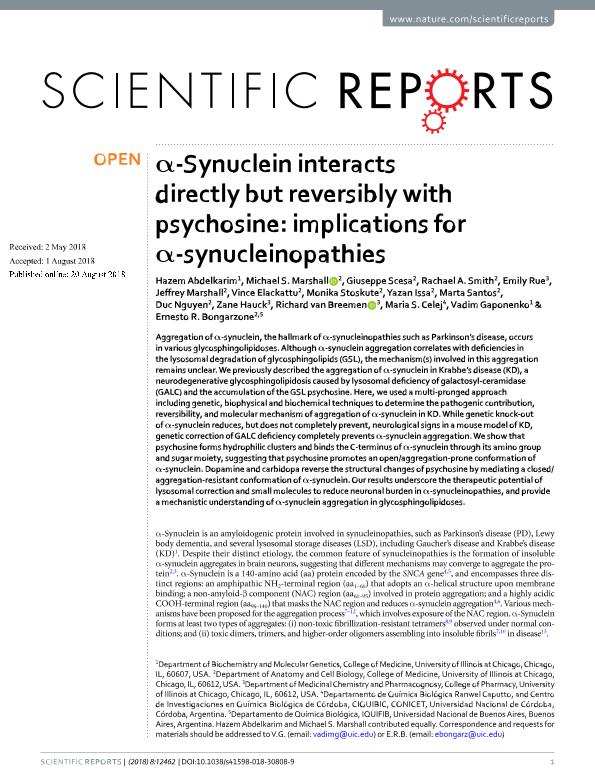Mostrar el registro sencillo del ítem
dc.contributor.author
Abdelkarim, Hazem
dc.contributor.author
Marshall, Michael S.
dc.contributor.author
Scesa, Giuseppe
dc.contributor.author
Smith, Rachael A.
dc.contributor.author
Rue, Emily
dc.contributor.author
Marshall, Jeffrey
dc.contributor.author
Elackattu, Vince
dc.contributor.author
Stoskute, Monika
dc.contributor.author
Issa, Yazan
dc.contributor.author
Santos, Marta
dc.contributor.author
Nguyen, Duc
dc.contributor.author
Hauck, Zane
dc.contributor.author
Van Breemen, Richard B.

dc.contributor.author
Celej, Maria Soledad

dc.contributor.author
Gaponenko, Vadim
dc.contributor.author
Bongarzone, Ernesto R.
dc.date.available
2020-06-02T19:22:35Z
dc.date.issued
2018-08
dc.identifier.citation
Abdelkarim, Hazem; Marshall, Michael S.; Scesa, Giuseppe; Smith, Rachael A.; Rue, Emily; et al.; α-Synuclein interacts directly but reversibly with psychosine: implications for α-synucleinopathies; Nature Publishing Group; Scientific Reports; 8; 1; 8-2018
dc.identifier.issn
2045-2322
dc.identifier.uri
http://hdl.handle.net/11336/106534
dc.description.abstract
Aggregation of α-synuclein, the hallmark of α-synucleinopathies such as Parkinson´s disease, occurs in various glycosphingolipidoses. Although α-synuclein aggregation correlates with deficiencies in the lysosomal degradation of glycosphingolipids (GSL), the mechanism(s) involved in this aggregation remains unclear. We previously described the aggregation of α-synuclein in Krabbe´s disease (KD), a neurodegenerative glycosphingolipidosis caused by lysosomal deficiency of galactosyl-ceramidase (GALC) and the accumulation of the GSL psychosine. Here, we used a multi-pronged approach including genetic, biophysical and biochemical techniques to determine the pathogenic contribution, reversibility, and molecular mechanism of aggregation of α-synuclein in KD. While genetic knock-out of α-synuclein reduces, but does not completely prevent, neurological signs in a mouse model of KD, genetic correction of GALC deficiency completely prevents α-synuclein aggregation. We show that psychosine forms hydrophilic clusters and binds the C-terminus of α-synuclein through its amino group and sugar moiety, suggesting that psychosine promotes an open/aggregation-prone conformation of α-synuclein. Dopamine and carbidopa reverse the structural changes of psychosine by mediating a closed/aggregation-resistant conformation of α-synuclein. Our results underscore the therapeutic potential of lysosomal correction and small molecules to reduce neuronal burden in α-synucleinopathies, and provide a mechanistic understanding of α-synuclein aggregation in glycosphingolipidoses.
dc.format
application/pdf
dc.language.iso
eng
dc.publisher
Nature Publishing Group

dc.rights
info:eu-repo/semantics/openAccess
dc.rights.uri
https://creativecommons.org/licenses/by-nc-sa/2.5/ar/
dc.subject
SYNUCLEIN
dc.subject
PSYCHOSINE
dc.subject
KRABBE
dc.subject
SYNUCLEINOPATHIES
dc.subject.classification
Bioquímica y Biología Molecular

dc.subject.classification
Ciencias Biológicas

dc.subject.classification
CIENCIAS NATURALES Y EXACTAS

dc.title
α-Synuclein interacts directly but reversibly with psychosine: implications for α-synucleinopathies
dc.type
info:eu-repo/semantics/article
dc.type
info:ar-repo/semantics/artículo
dc.type
info:eu-repo/semantics/publishedVersion
dc.date.updated
2019-10-22T16:42:51Z
dc.journal.volume
8
dc.journal.number
1
dc.journal.pais
Reino Unido

dc.journal.ciudad
Londres
dc.description.fil
Fil: Abdelkarim, Hazem. University of Illinois; Estados Unidos
dc.description.fil
Fil: Marshall, Michael S.. University of Illinois; Estados Unidos
dc.description.fil
Fil: Scesa, Giuseppe. University of Illinois; Estados Unidos
dc.description.fil
Fil: Smith, Rachael A.. University of Illinois; Estados Unidos
dc.description.fil
Fil: Rue, Emily. University of Illinois; Estados Unidos
dc.description.fil
Fil: Marshall, Jeffrey. University of Illinois; Estados Unidos
dc.description.fil
Fil: Elackattu, Vince. University Of Illinois Chicago; Estados Unidos
dc.description.fil
Fil: Stoskute, Monika. University Of Illinois Chicago; Estados Unidos
dc.description.fil
Fil: Issa, Yazan. University Of Illinois Chicago; Estados Unidos
dc.description.fil
Fil: Santos, Marta. University Of Illinois Chicago; Estados Unidos
dc.description.fil
Fil: Nguyen, Duc. University Of Illinois Chicago; Estados Unidos
dc.description.fil
Fil: Hauck, Zane. University Of Illinois Chicago; Estados Unidos
dc.description.fil
Fil: Van Breemen, Richard B.. University Of Illinois Chicago; Estados Unidos
dc.description.fil
Fil: Celej, Maria Soledad. Consejo Nacional de Investigaciones Científicas y Técnicas. Centro Científico Tecnológico Conicet - Córdoba. Centro de Investigaciones en Química Biológica de Córdoba. Universidad Nacional de Córdoba. Facultad de Ciencias Químicas. Centro de Investigaciones en Química Biológica de Córdoba; Argentina
dc.description.fil
Fil: Gaponenko, Vadim. University Of Illinois Chicago; Estados Unidos
dc.description.fil
Fil: Bongarzone, Ernesto R.. University Of Illinois Chicago; Estados Unidos
dc.journal.title
Scientific Reports
dc.relation.alternativeid
info:eu-repo/semantics/altIdentifier/url/http://www.nature.com/articles/s41598-018-30808-9
dc.relation.alternativeid
info:eu-repo/semantics/altIdentifier/doi/http://dx.doi.org/10.1038/s41598-018-30808-9
dc.relation.alternativeid
info:eu-repo/semantics/altIdentifier/url/https://www.ncbi.nlm.nih.gov/pmc/articles/PMC6102231/
Archivos asociados
